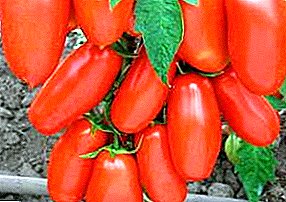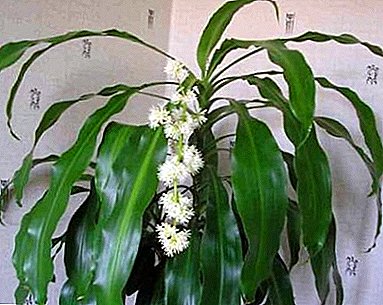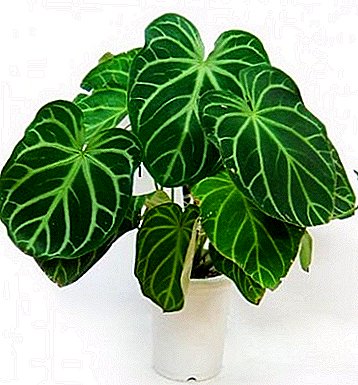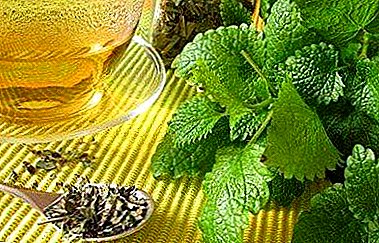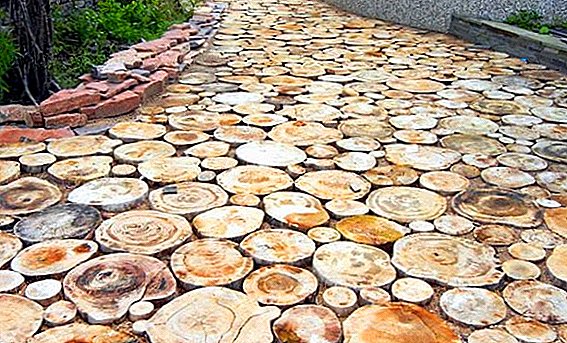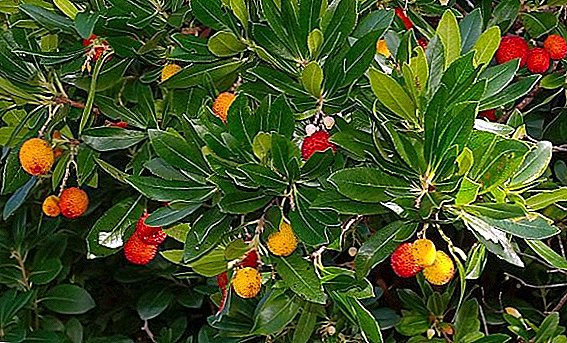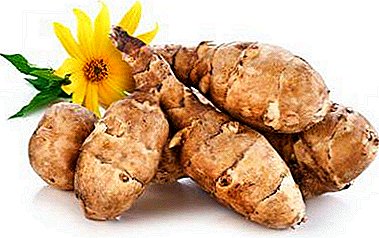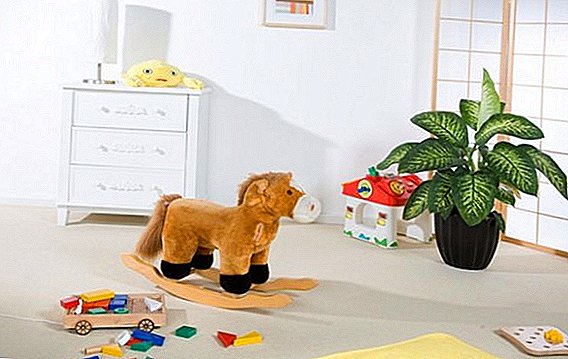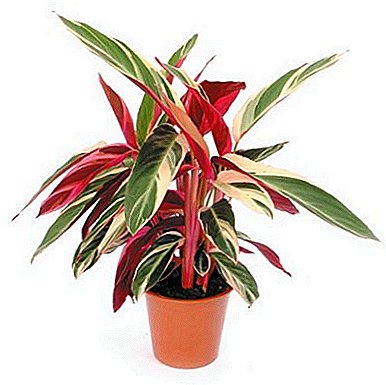
Stromanta - A fairly frequent visitor to the collections of indoor flowers.
Such popularity is due to the particular ornamental nature of the leaves of the plant, which have an unusual, as if specially painted color.
Description
Stromanta - decorative leafy perennial from the family maranth. She comes from South and Central America. Stromant has large, elongated leaves with cream, white and pink stripes on a green background. On the underside of the sheet is painted in purple-purple color.
At home, grows from 60 to 80 centimeters. In nature, the plant blooms in summer with white or pink flowers. The leaves of the stromancy have the peculiarity of rising and flaking in the evening, they become like folded hands for prayer.
There are about 13 species, only Pleasant and Blood-Red are grown at home. However, keeping a plant in a room is quite difficult, since need a special balance of temperature and humidity. Therefore, it feels better in the greenhouse or greenhouse, and at home it is better to keep it in florariums or bottle gardens.
Flowers

When grown at home, the flowers on the plant appear very rarely.
But if you create ideal conditions for it, the stromante throws out a long flower spike with small red or white flowers.
Its inflorescence resembles a magnificent spikelet.
Stromanta in your house
This plant is able to decorate the interior of any style. Its leaves are so original coloring that give the plant a very attractive, even somewhat exotic look.
A photo
Visually get acquainted with the plant Stromanta can be in the photo below:




Home care
Consider the individual stages of home care for the plant stromant.
Growing rules
Plant pretty capricioustherefore, to preserve its decoration and successful growth, it is necessary to observe some features of the content.
Location in the house
The best is Stromant cultivation on the east or west side. Near the south window, she will need shading, and next to the north she will need additional lighting with luminescent or special fitolamps.

Temperature and humidity
Stromantus flower loves warm and high humidity. It is tropical conditions with an air temperature of 20-30 degrees and a humidity of at least 70% that the stromante needs for successful growth and good health.
If the air in the apartment is dry, it is necessary to spray the plant 1-2 times a day with soft, warm water.
It is advisable to put the pot in a pan with pebbles or expanded clay, and pour water on it.
At night, you can cover the flower with a transparent cap. You can grow stromanta in an aquarium, there is the easiest to create the perfect combination of humidity and high temperature.
IMPORTANT! When installing the pot in the pan with expanded clay, make sure that the bottom does not touch the water. From excess moisture roots will begin to rot.
Watering
The plant needs a lot of water, but necessarily filtered or settled. In addition, the water temperature should be several degrees above room temperature.
IMPORTANT! Watering with cold water creates stress for the plant, and it will start to hurt.
When watering it is important to maintain a balance - the soil should not dry out. But its wetting is not acceptable.
Before the next watering should dry out the top layer of soil. From the pallet excess water must be drained.
In winter, the amount of moisture and the frequency of watering sharply reduced.
What to feed?
During the growing season, the stromanta is fertilized once every two weeks. Suitable for feeding universal mixture for indoor plants.
Only dilute half the recommended dose, as it does not tolerate excess minerals, especially calcium. Winter feeding is not needed.
Soil composition
Need stromante loose soil is slightly acidic. Plant roots should receive the maximum amount of air.
Ideal for a plant would be a composition of turf, peat and sand (2X1X1). For disinfection is added a little charcoal.
You can also use purchased substrates for maranty, azaleas or palm trees.
Transplant and pruning
Stromant transplant transshipment method. Young specimens need to be transplanted annually, adults - once every two years.
The capacity for the transplant is taken of a larger diameter than the previous one. The roots of the plant are quite long, so for their comfortable placement you need to take a high pot. Pot bottom necessarily follows cover with a large layer of drainage mixture.
During transplantation, I prune dried and damaged leaves. In the formation of the crown of stromanth does not need.

Breeding methods
Propagate the plant in three ways:
- The division is carried out in the spring during transplantation. The bush is divided into two, sometimes three parts, and is seated in a slightly damp soil. Then the bushes need to be given time to adapt and water only when the soil dries.
At the beginning of rooting, it is better to cover each copy with a transparent cap to create greenhouse conditions.
- Cuttings. It is carried out by apical cuttings. The best time is spring. Preparations of 10-11 cm are taken from young shoots, each should have several leaves. To form the roots, they are placed in a mini-greenhouse in a glass with water. soil.
- Sowing seeds. Stromant seeds are quite capricious and have poor germination. In order to seed a flower, you need to be patient and have high-quality seed.
Sow them in the most loose peat-sand mixture and place the dishes with crops in the mini-greenhouse.
Only there it is possible to maintain a constant temperature and humidity, otherwise the seeds will not grow.
If to create suitable conditions, then in 25-30 days sprouts will appear. They can be planted in pots at the age of 2-2.5 months.

Pests
Like most of the indoor plants, the stromant is affected by the following insects:
- Shchitovka. The leaves are covered with brown specks, they turn pale and begin to dry out, as the pest sucks out the juice. The trim is cleaned with a cotton swab dipped in a solution of laundry soap. Then the plant is treated with the drug Actellic.
- Spider mite. When it multiplies, leaves are covered with white bloom. Usually a tick appears if the air in the apartment is too dry. Stromants washed with soapy water, and then treated with an insecticide.
- Mealybug. When it appears, the leaves begin to curl. The plant should be wiped with cotton wool moistened in an alcohol solution and treated with insect poison.
Strongly affected areas are best removed..
Problems and Diseases
If you do not comply with the necessary conditions for keeping Stromants at home, she will signal you with the following manifestations:
- Leaf drying. It comes from an excess of direct sunlight, the plant should be pritenit.
- Leaves wither. So the flower is cold and damp. Normalize watering and move the plant to a warmer room.
- Stromants dry leaf tips. This suggests that the air is too dry.
- Dark spots on the leaves. The plant does not have enough moisture in the soil or too long intervals between watering are allowed.
- Pale pink stripes. The light when growing is not bright enough.
The same diseases and problems have plants: Calathea Crocate, Calathea Makoy.
The fastidious beauty of the stromante requires constant increased attention.
But if you give her time and satisfy her whims, she will delight you with beautiful foliage and become a real decoration of your home.


